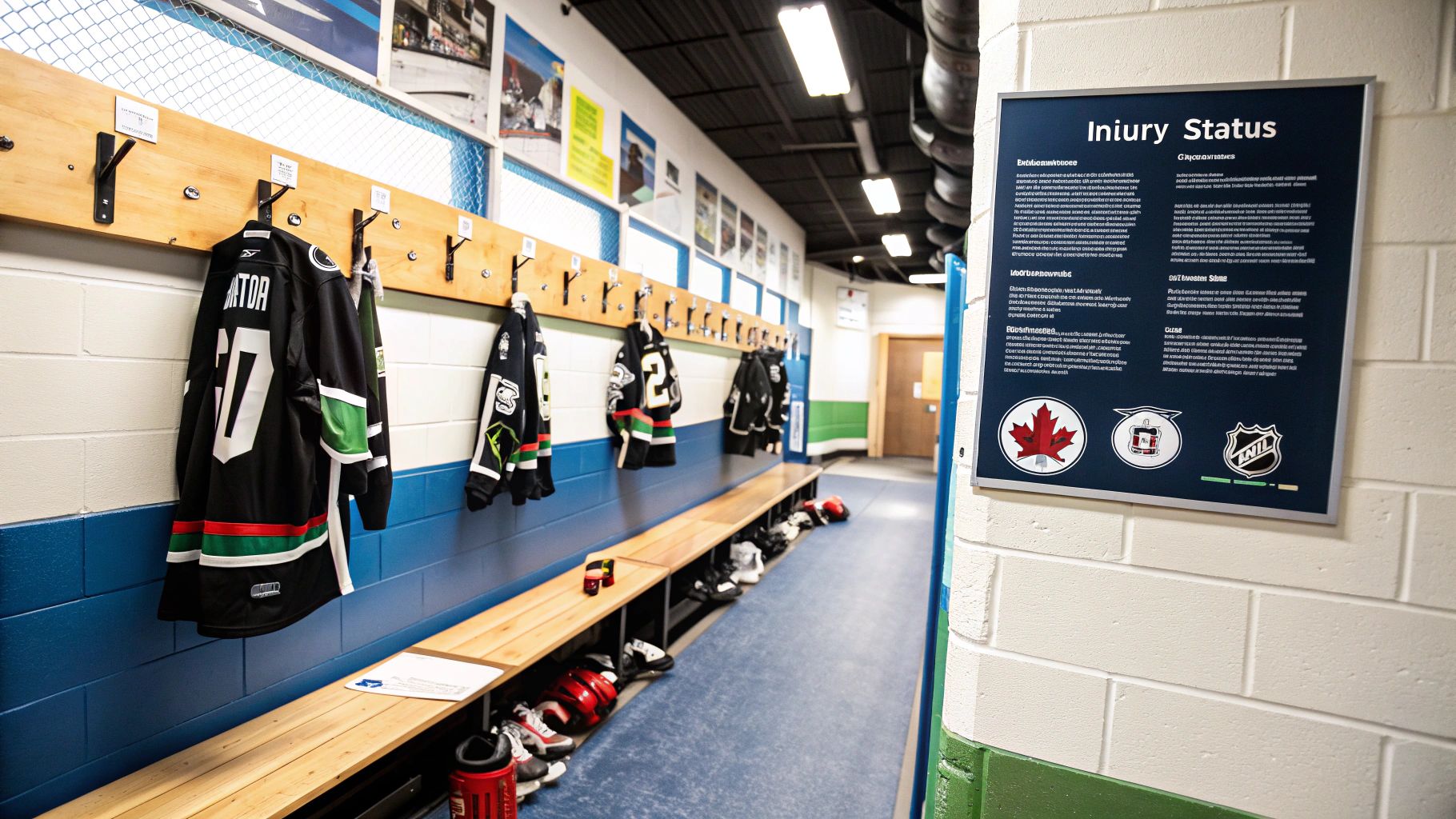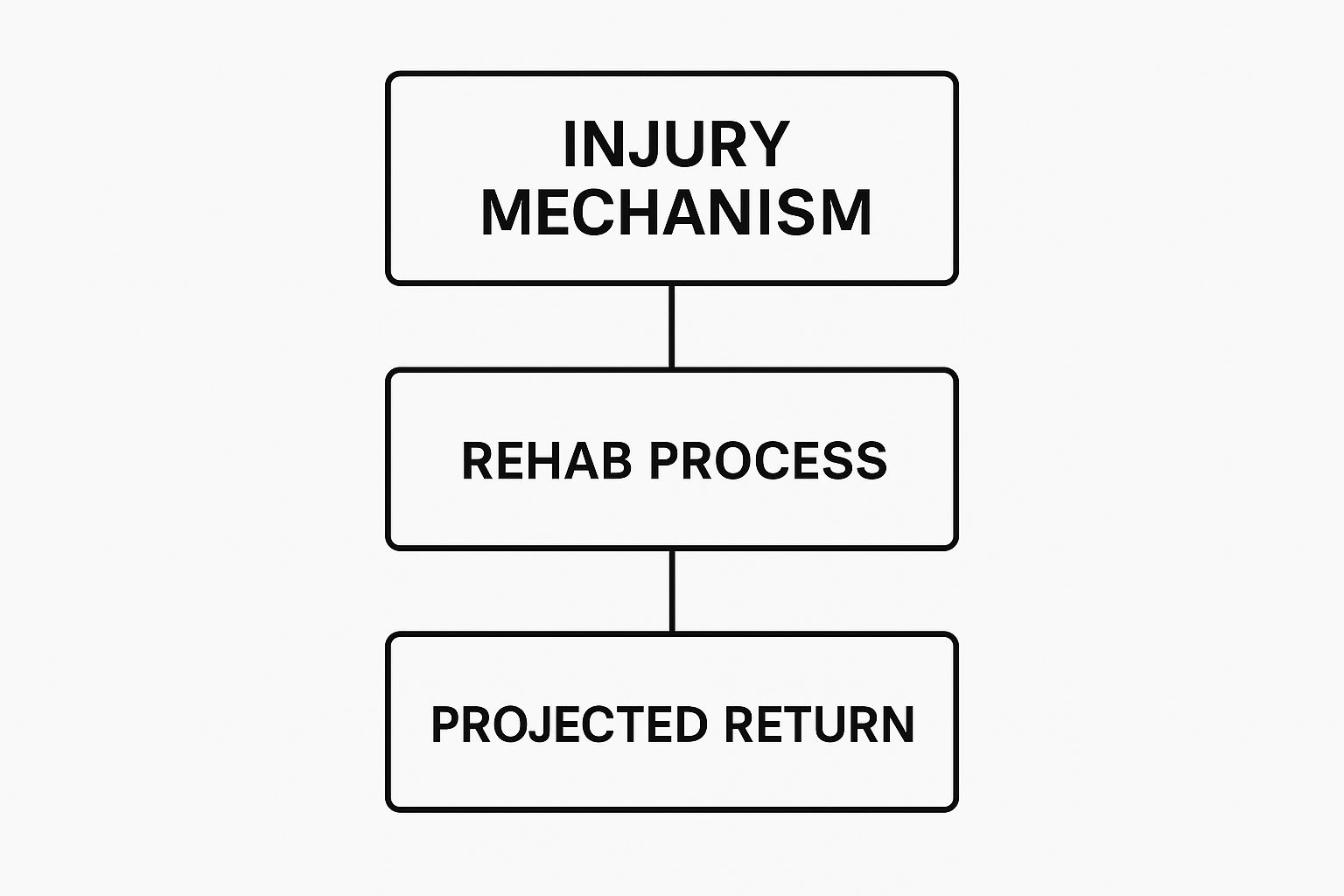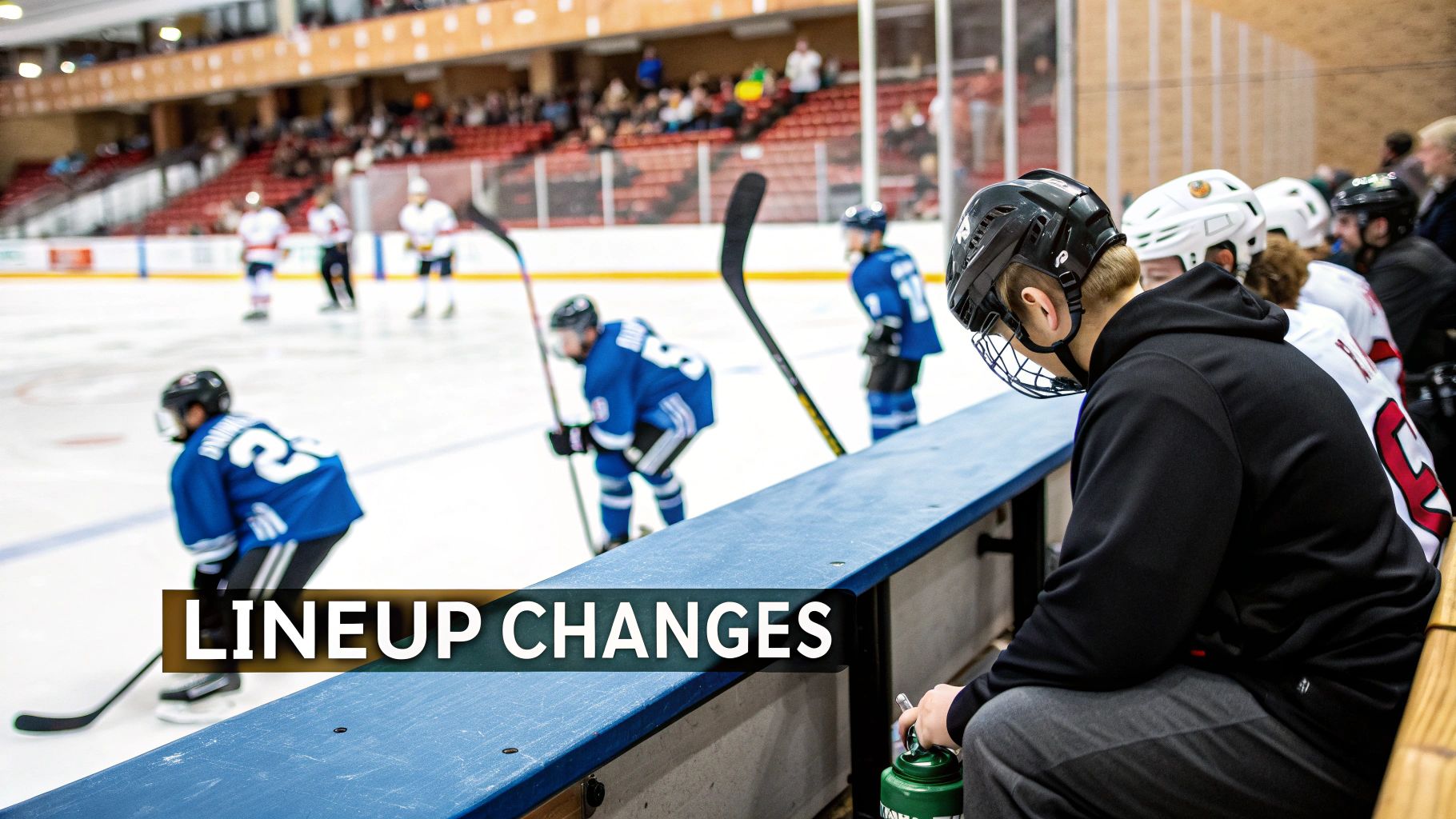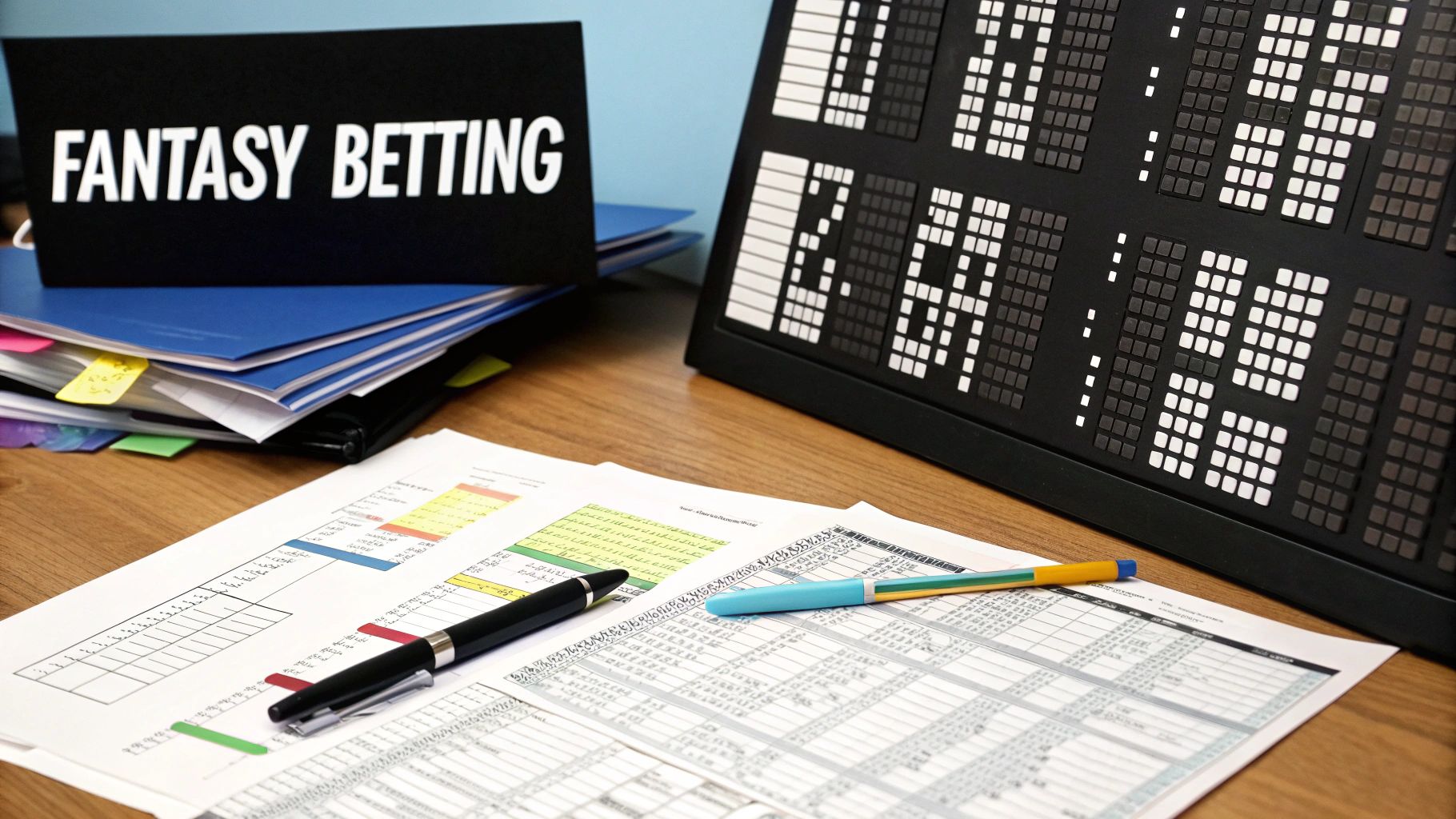Your Essential Vancouver Canucks Injury Report

The Canucks injury report is already making for some tough reading early in the 2025-26 season, with several key players hitting the shelf before the team could even find its rhythm. Right out of the gate, Vancouver is dealing with some significant holes in its roster, testing both forward depth and defensive pairings.
Navigating the Canucks Current Injury Landscape

For any fan, keeping tabs on who's in and who's out is essential. An injury isn't just one player leaving the lineup; it kicks off a domino effect that messes with line chemistry, scrambles special teams, and forces the coaching staff to get creative. Think of it as a puzzle where you suddenly have to find new pieces to fill unexpected gaps.
For fantasy hockey managers, this is the intel needed to hit the waiver wire. For sports bettors, it's a critical factor that can swing betting odds in an instant.
Early Season Absences
As the 2025-26 NHL season gets underway, the Canucks are already feeling the pinch. Newcomer Pierre-Olivier Joseph is on injured reserve with an undisclosed issue, and he's not expected back until at least mid-October 2025.
The forward group is also taking a hit. Energetic winger Nils Hoglander has been sidelined since early October with a lower-body injury, and his return isn't anticipated until late November. To make matters worse, dependable centre Teddy Blueger is also out with an undisclosed injury, though his timeline is shorter, aiming for a mid-October return. For the latest on timelines across the league, you can always track the latest NHL injury updates.
An injury report is more than just a list of names; it’s a snapshot of a team’s resilience. It reveals which depth players will get a chance to prove themselves and how the coaching staff will adapt under pressure.
To give you a quick, clear look at the situation, here’s a summary of the current Vancouver Canucks injury report.
Vancouver Canucks Active Injury List
This table is your quick-reference guide to every player currently sidelined, laying out their status and when we might see them back on the ice.
| Player Name | Position | Injury Details | Status | Projected Return |
|---|---|---|---|---|
| Pierre-Olivier Joseph | D | Undisclosed | Injured Reserve | Mid-October 2025 |
| Nils Hoglander | LW | Lower-Body | Out | Late-November 2025 |
| Teddy Blueger | C | Undisclosed | Day-to-Day | Mid-October 2025 |
Having this info handy makes it easier to understand the team's nightly lineup decisions and the challenges they're facing to stay competitive.
Digging Into Each Player's Road to Recovery
To really get a handle on the Canucks injury report, you have to look past generic labels like "upper-body" or "lower-body." Every injury tells a story. It’s a unique journey shaped by the player's role on the ice, the specific ailment, and the brutal demands of pro hockey. An injury isn't just a physical problem; it's a whole process of diagnosis, rehab, and eventually, getting back into game shape.
Think of it like building a house. First, you lay the foundation—that's the initial diagnosis and rest. Next comes the framing, which is all the targeted physiotherapy and strength work. Finally, you get to the finishing touches: conditioning skates, on-ice drills, and eventually, full-contact practices to make sure everything holds up under pressure. If you rush any of these steps, you risk a setback, so a patient, deliberate approach is everything.
A Closer Look at the Current Injuries
Let’s break down what’s happening with the players currently on the shelf. Each situation is a different puzzle for the player and the team's medical staff to solve.
Nils Hoglander (Lower-Body): A lower-body injury for a guy like Hoglander is a huge deal. His entire game is built on explosive speed, agility, and hounding the puck in the corners. Any injury that impacts his skating—be it a groin, knee, or ankle—cuts right to the core of his effectiveness. The fact his timeline extends to late November hints at a pretty significant muscle or ligament issue that needs careful management to get that explosive power back.
Pierre-Olivier Joseph (Undisclosed): When a defenseman has an "undisclosed" injury, it often means it’s something opponents could easily target. It could be anything from a core muscle injury that affects his pivots and lateral movement, to a wrist or shoulder problem that makes it tough to clear the crease or win board battles. The team keeps it quiet for a reason—to protect him when he returns.
Teddy Blueger (Undisclosed): Blueger is a classic two-way, responsible centre, so his absence creates a hole at both ends of the ice. For a player who eats up key defensive minutes and kills penalties, an undisclosed injury often points to the torso or upper body. These are the common casualties of blocking shots and battling in front of the net.
This diagram lays out the typical path from the initial incident to, hopefully, a full return.

As you can see, that rehabilitation phase is the critical bridge between getting hurt and getting back on the ice.
What Those Vague Injury Terms Really Mean
NHL teams are notoriously secretive about injuries. It’s all about competitive advantage. But if you know how to read between the lines, you can get a better sense of what’s going on.
- Upper-Body Injury: This is a catch-all term for anything from a concussion or a separated shoulder to a broken hand. The big question is always how it affects a player's ability to handle the puck, shoot, and mix it up physically.
- Lower-Body Injury: This usually points to the legs, hips, or groin. These are often the most frustrating injuries because they mess with the most fundamental skill in hockey: skating.
- Undisclosed: This is pure strategy. The team either wants to keep opponents from targeting a weak spot when the player returns, or they're still figuring out just how bad it is.
"Teams don't get pushed around... Part of that good defensive hockey that we play is the chances that we give up... a lot of that has to do with us not running around getting out of position to finish checks." - Coach Kris Knoblauch
That quote really nails the team’s mindset. It’s all about smart, positional hockey—something that becomes even more critical when key guys are out of the lineup. The remaining players have to be that much more disciplined to fill the void.
How Injuries Reshape the Canucks Lineup

When a player lands on the Canucks injury report, it’s never just about one guy being out. It sets off a chain reaction, a strategic shuffle that echoes through every forward line and defensive pair. The coaching staff is instantly thrown into a game of chess, moving pieces around to plug a hole while trying desperately not to create three more.
Think of it like an orchestra losing its first-chair violin. You can't just slide another violinist into the seat and expect the same result. The whole string section might need rearranging to balance the sound, changing the entire ensemble's rhythm and feel. That's exactly what happens on the ice.
A top-six forward's absence doesn’t just mean a third-liner gets a few more shifts. It often means the entire top-six gets blended, with wingers swapping sides and centres taking on new matchups. This creates a fascinating mix of challenges and unexpected opportunities up and down the roster.
The Next Man Up Mentality
For depth players and prospects waiting in Abbotsford, an injury is the ultimate opportunity. A fourth-line grinder might suddenly find himself auditioning for a key penalty-killing role. A hotshot AHL call-up could get the chance of a lifetime, skating alongside veteran playmakers.
These moments are where careers can be made. It's invaluable NHL experience that you just can't simulate in practice or the minors.
When the coaches start tinkering, they’re weighing a few key factors:
- Player Skillset: Does the replacement have the wheels to keep up on a scoring line? Or the defensive instincts for a shutdown role?
- Existing Chemistry: Have two guys shown a bit of a spark together in limited minutes? Now might be the time to put them together for good.
- Positional Versatility: Can a natural centre shift to the wing to make it work? Can a winger play his off-side?
These decisions are rarely clean and often lead to some in-game experimenting as the coaches hunt for a combination that clicks.
The ripple effect of an injury is most profound on special teams. Losing a power-play quarterback or a key penalty killer forces a complete rethink of units that rely heavily on repetition and instinct.
Visualizing the Lineup Shift
To really grasp the domino effect, let’s map out a quick "before and after." Imagine the Canucks lose their top-line right winger.
Before Injury (Top Six Forwards):
- Line 1: Player A - Player B - INJURED PLAYER
- Line 2: Player C - Player D - Player E
After Injury (Potential Adjustments):
- Line 1: Player A - Player B - Player E (Promoted from 2nd line)
- Line 2: Player C - Player D - AHL Call-Up (Given a sheltered role)
See what happens? That one simple move changes everything. Player E is now facing the other team's best defenders, a huge step up. Meanwhile, the second line has to break in a brand new player, completely altering its chemistry and rhythm.
Nowhere is this more obvious than on the power play. Losing one key shooter or passer can tank your efficiency overnight. To see just how much these shuffles matter, you can check out detailed breakdowns of NHL special teams rankings. It quickly becomes clear which teams adapt to roster chaos and which ones crumble.
Ultimately, the team’s entire identity gets tested. A gritty, defence-first approach might be needed to grind out wins. As the coaching staff has noted, the focus shifts to disciplined, positional hockey, ensuring players aren't "running around getting out of position to finish checks." It’s a tactical retreat, a direct response to missing the offensive firepower needed to win a track meet.
Putting Canucks Injuries in Historical Context
For Canucks fans, a lengthy injury report isn't a surprise; it's practically a tradition. Overcoming adversity has defined entire eras of Vancouver hockey, with key players going down at the worst possible times. But looking back at those moments gives us a bit of perspective on the team's current situation.
Think of it like this: the organization has been through these storms before. They've learned how to patch the holes, adjust the sails, and somehow keep the ship afloat. While every new injury feels like a crisis, the team has a long track record of weathering these challenges and finding ways to stay competitive.
This history shows that while losing a star player hurts, it also forces others to step up. It's a test of an organization's depth and a chance for a new hero to emerge.
Memorable Seasons Defined by Injuries
If you look back through the years, you'll find plenty of seasons where the Canucks' medical staff was as crucial as the coaching staff. The team has been hit hard time and time again, testing its depth and resolve.
Take the 2008-09 season, when star goaltender Roberto Luongo went down with a groin injury for two months, forcing the team to rally around its backup. A few years later, in the lockout-shortened 2012-13 season, two-way force Ryan Kesler missed a huge chunk of time, completely changing the team's identity on the ice. You can read more about how the team has battled these issues in this deep dive into the history of Canucks injuries.
And it didn't stop there. The injury bug just kept biting.
- The 2017-18 Campaign: This season was a slow burn of bad luck, with a constant stream of core players heading to the IR, completely sinking any playoff aspirations.
- The 2018-19 Follow-Up: The bad luck continued. Brandon Sutter was hit with both a shoulder injury and a hernia, while a young Elias Pettersson was sidelined with a concussion.
This isn't about dwelling on painful memories. It's about recognizing that resilience is baked into the Canucks' DNA. The ability to grind out wins without your best players is a skill this franchise has been forced to learn out of sheer necessity.
Lessons Learned from Past Adversity
Every one of those injury-plagued seasons taught the organization something valuable. When Luongo went down, it drove home the importance of a reliable backup goalie and a tight defensive system. Kesler's absence proved you need versatile forwards who can kill penalties one shift and create offence the next.
These past struggles are basically a playbook for the current front office and coaching staff. They show how smart call-ups from the AHL, tactical tweaks, and shuffling lines can keep a team in the fight, even when its stars are out.
Today's Canucks injury report is just the latest test in a long history of adaptation and perseverance.
Fantasy Hockey and Betting Angles

The official Canucks injury report isn't just a list of bumps and bruises for fans to worry about. For fantasy hockey managers and sports bettors, it’s a blinking neon sign pointing toward opportunity. Every time a key player goes down, the entire fantasy and betting landscape shifts, creating value where there was none before.
Think of it like the stock market. When a blue-chip company—your star player—stumbles, their value dips. Suddenly, savvy investors start sniffing around for undervalued assets, or depth players, who are about to see a promotion. That’s exactly the game here. Ignoring injury news is like leaving free money on the table.
Navigating the Fantasy Waiver Wire
For fantasy GMs, a top-six forward or top-pairing defenceman hitting the IR is a call to action. It’s time to hit the waiver wire and find the "next man up." The trick is figuring out who is about to inherit the most valuable ice time—especially on the power play.
When a guy like Nils Hoglander is out, his minutes are suddenly up for grabs. Here’s what you need to look for immediately:
- Increased Ice Time: Who saw their time on ice jump in the very next game? A forward going from 12-13 minutes a night to 16-17 minutes is a huge tell.
- Power Play Promotion: Did a third-liner suddenly get a shot on the first or second power-play unit? That’s the single biggest gold flag for a potential offensive explosion.
- Linemate Quality: Who is the replacement skating with now? A player slotted next to Elias Pettersson has a much higher fantasy ceiling than someone stuck on the fourth line.
This is where you unearth those league-winning gems. To get a better handle on who might be climbing the depth chart, you can check out detailed fantasy NHL rankings for 2025 and spot players with untapped potential.
In fantasy hockey, opportunity is just as valuable as talent. A moderately skilled player on the top power-play unit is often a better short-term bet than a highly skilled player buried on the third line.
How Injuries Influence Betting Lines
Sportsbooks aren't sleeping on this stuff; they react to injury news in real-time. The absence of a key player, especially a starting goalie or a top goal-scorer, can completely change the betting odds for a game. For bettors, this is where you can find an edge.
Let’s say the starting goalie is a last-minute scratch. The over/under for total goals will almost certainly tick upwards. Or if the team’s top scorer is out, their opponent's moneyline might suddenly look more attractive as oddsmakers adjust for the Canucks' weakened offence.
Keep an eye on these specific areas for value:
- Moneyline: The odds on the healthy opposing team will usually shorten (become less profitable), but sometimes the adjustment isn’t quite enough, leaving a little meat on the bone.
- Puck Line: With a key scorer out, the Canucks might be a smarter bet to cover a +1.5 puck line, especially if you expect them to clamp down and play a tighter, lower-scoring game.
- Player Props: This is where the impact is most direct. With a star out, look for increased shot or point props for the players who are expected to pick up the offensive slack.
Looking Ahead at the Team's Path Forward
As players start trickling off the Canucks injury report and back into the lineup, the team hits a tricky new phase. It’s not as simple as just pencilling a guy’s name back onto the roster sheet. The real challenge is plugging a player back in who’s been out of sync with the blistering pace of the NHL.
Getting a player back is one thing; getting them back to their old self is another beast entirely. Skaters almost always struggle to get their game speed, timing, and that unspoken chemistry with their linemates back. It’s a process that demands patience from everyone—the player, the coaches, and especially the fans.
Challenges and Hidden Benefits
The reintegration process is loaded with hurdles. A player might be physically cleared to play, but mentally, they're still hesitant, subconsciously protecting the spot where they got hurt. This can cause a temporary dip in performance as they learn to trust their body again in the heat of battle.
But there’s a massive silver lining to these injury spells. When veterans go down, it shoves young prospects into the deep end, giving them meaningful NHL minutes they’d never get otherwise. This baptism by fire is an incredible development tool, fast-tracking their growth and giving management a much clearer look at what they have for the future.
This kind of adversity is what really shows you the true depth of an organization. The experience those call-ups and depth players gain creates a stronger, more resilient roster for the long haul and playoff pushes.
This exposure can have a huge impact on future roster decisions. To get a sense of how these experiences shape the team's long-term strategy, it's worth digging into the patterns in the Vancouver Canucks draft history to see how prospects are found and developed.
Ultimately, how the Canucks manage these returns will define the rest of their season, hopefully turning a bit of short-term pain into some serious long-term strength.
Your Top Canucks Injury Questions Answered
Even with all the details, tracking injuries can get confusing. Let's clear up some of the most common questions fans have about the Canucks injury report, from where to get the best info to why teams are so secretive about it.
Where Can I Find the Most Reliable Canucks Injury Updates?
For the official word, your first stops should always be the Vancouver Canucks' official website and their social media channels. That's where news is confirmed.
But for the minute-to-minute updates and a bit more context, you can't beat the insiders. Guys like the team beat reporters at TSN and Sportsnet are your best bet. They're at the practices and in the scrums, often tweeting out information long before it becomes an official press release.
What’s the Difference Between IR and LTIR?
Think of Injured Reserve (IR) and Long-Term Injured Reserve (LTIR) as two different tools in a GM's toolkit for managing an injured roster. They serve similar but distinct purposes.
IR (Injured Reserve): This is the short-term solution. A player has to miss at least seven days. Putting them on IR frees up a spot on the 23-man active roster, letting the team call someone up from Abbotsford. The key thing here is that the player's salary still counts against the team's salary cap.
LTIR (Long-Term Injured Reserve): This is for more serious situations. A player must be expected to miss at least 10 NHL games and 24 days. The big advantage of LTIR is that it gives the team salary cap relief, allowing them to exceed the cap by roughly the amount of the injured player's hit to bring in a replacement.
The real difference boils down to the salary cap. IR is just about roster flexibility. LTIR is about getting critical financial breathing room when a key player goes down for a long time.
Why Are NHL Injuries So Vague?
You'll almost always hear "upper-body" or "lower-body" injury, and it's completely intentional. This isn't just teams being difficult; it's a strategic move.
If a team announces a player is recovering from, say, a left shoulder injury, you can bet that every opponent for the next month will be targeting that exact spot. Keeping the details vague protects the player from being targeted when they return to the ice. It’s a league-wide practice that balances the public's desire for info with a player's safety and medical privacy.
For the deepest player stats and team analytics to complement any injury report, explore the tools at PuckNStick. Dive into the data at https://www.pucknstick.com.
